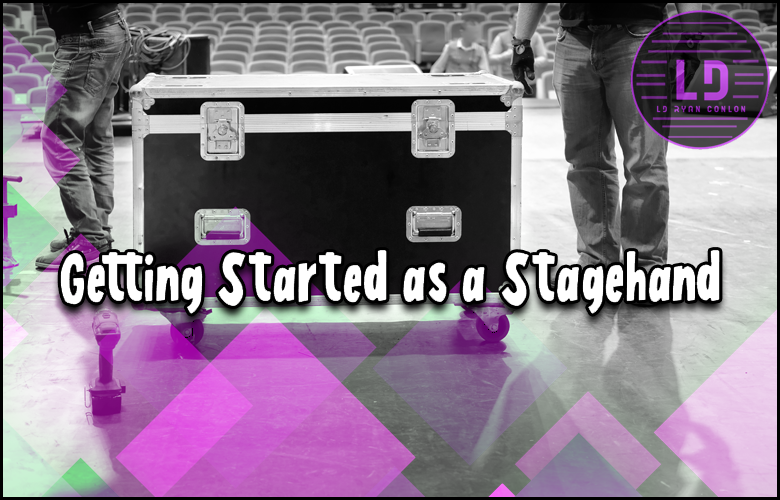
Last Updated on May 10, 2025 by LD Ryan Conlon | 🕒 [reading-time]
So, you’ve been spellbound by the magic of theater and have decided to translate your love for dramatic arts into a vibrant career, not under the dazzling lime lights but behind the scenes.
Here’s an exciting revelation – becoming a stagehand can be your secret entry into this enchanting world! This beginner’s guide will help you navigate through the backstage drama, shedding light on how to start your career as a stagehand.
Be prepared to uncover practical advice, insider tips, and step-by-step training pathways essential for mastering the art of stage work, where every cue is crucial and each prop pivotal.
Ready to pull some curtains? Your journey starts here.
To get started as a stagehand, there are several pathways you can consider. One option is to obtain a university degree or complete a college course related to stage and production management, sound engineering, or theater and production arts. Another option is to pursue an apprenticeship in the field, such as the Creative Venue Technician Level 3 or Creative Industries Production Technician Level 3. Additionally, gaining practical experience by assisting with local theater productions, attending rehearsals, and learning from experienced professionals can help you build your skills and network in the industry.
Understanding the Stagehand Role
Being a stagehand is an integral part of the theater industry, involving behind-the-scenes work that brings productions to life.
To truly understand the stagehand role, it’s important to recognize their crucial contributions and the responsibilities they undertake.
Stagehands provide support for various aspects of a production, ensuring smooth operations and flawless performances.
At its core, a stagehand is involved in the manual labor and technical aspects of theater productions.
This can range from setting up props and scenery to operating lighting and sound equipment during performances.
They are the unsung heroes who work diligently to create the magical world audiences see on stage.
One of the defining aspects of being a stagehand is versatility.
They must be adaptable as their tasks can vary greatly from one production to another.
In one show, they might be focused on building intricate sets, while in another, they might be operating complex machinery for scene changes.
Stagehands are also responsible for ensuring safety within the theater environment.
They must be aware of potential hazards and take necessary precautions to protect themselves and others.
Whether it’s securing heavy equipment or following proper protocols for rigging, safety is always a top priority.
For example, imagine you are working as a stagehand for a Broadway musical.
Your day might involve assisting with loading and unloading equipment for rehearsals or performances, working alongside carpenters to construct scenic elements, coordinating with costumers for quick changes backstage, or even handling pyrotechnics or special effects during shows.
Understanding the dynamics of teamwork is another critical aspect of being a successful stagehand.
They often collaborate closely with other members of the production team, such as directors, designers, technicians, and performers.
Communication skills and the ability to effectively work in a group setting are essential to ensure everyone is on the same page and to deliver seamless performances.
A career as a stagehand can be physically demanding and mentally challenging, but it offers significant rewards for those who are passionate about the theater.
It provides a unique opportunity to contribute to the creation of memorable experiences for audiences night after night.
Now that we have gained an understanding of the stagehand role, let’s explore the different types of stagehands one may encounter in the theater industry.
- The U.S Bureau of Labor Statistics reported in 2020 that jobs for set and exhibit designers, which include stagehands, are expected to grow about 6% from 2019-2029, faster than the average for other occupations.
- According to Payscale, as of 2023, the average wage for a stagehand is around $17.50 per hour, with experienced professionals earning up to $30 per hour.
- A survey conducted by CareerExplorer in 2022 showed that approximately 70% of stagehands have completed some form of vocational training or college education related to theater and production arts.
- Being a stagehand is a crucial and versatile role in the theater industry, involving manual labor and technical responsibilities that bring productions to life. Stagehands are responsible for setting up props and scenery, operating lighting and sound equipment, ensuring safety, and collaborating with other members of the production team. A career as a stagehand requires physical stamina, mental agility, and a passion for creating memorable experiences for audiences.
Different Types of Stagehands
The world of theater is diverse, and so are the roles and responsibilities encompassed by stagehands.
Understanding the different types of stagehands can help aspiring professionals navigate their desired career path within the industry.
- Carpentry Stagehand: These stagehands specialize in constructing and manipulating sets, props, platforms, and other wooden elements required for productions. They possess excellent woodworking skills and knowledge of structural design.
- Lighting Stagehand: Lighting stagehands work closely with lighting designers to set up and operate lighting equipment during performances. They are responsible for creating the ambiance, effects, and cues that enhance the overall visual experience on stage.
- Sound Stagehand: Sound stagehands focus on audio equipment and systems during productions. They work alongside sound engineers to ensure clear sound projection, microphone placement, and seamless playback of recorded music or sound effects.
- Fly/Rigging Stagehand: These stagehands handle all aspects related to flying scenery or performers during productions. They operate complex rigging systems to lift or lower objects as required by the production design.
- Props Stagehand: Props stagehands are responsible for gathering, organizing, setting up, and maintaining props used in a production. This includes everything from small handheld items to larger set pieces.
- Stage Crew Chief/Head Carpenter: This role involves overseeing a group of stagehands or being responsible for coordinating activities related to carpentry duties on larger productions.
The specific tasks performed by each type of stagehand may vary based on the production’s requirements and the size of the theater.
However, these roles provide a starting point for aspiring stagehands to explore different avenues within their chosen field.
For example, imagine you are passionate about lighting design.
As a lighting stagehand, you would work closely with lighting designers to set up and focus lights, program lighting cues, and ensure proper functioning of equipment during performances.
Now that we have explored the various types of stagehands, it’s important to understand the essential skills required to excel in this dynamic role.
Essential Skills for Stagehands
Being a stagehand requires a unique set of skills that enable you to work efficiently and effectively behind the scenes in the theater industry.
Whether you’re assisting with set construction, operating equipment, or ensuring the smooth running of performances, here are some essential skills for stagehands:
- Knowledge of Building and Construction: As a stagehand, you will often be involved in constructing sets and platforms. Understanding basic building and construction principles is crucial to ensure the safe and secure assembly of staging elements.
- Ability to Use, Repair, and Maintain Machines and Tools: Stagehands need to be familiar with various machinery and tools used in theater production, such as power tools, rigging systems, lighting consoles, and audio equipment. Being able to use these tools effectively and troubleshoot any technical issues that arise is essential.
- Ability to Work Well with Others: Theater productions involve teamwork and collaboration. Stagehands need to be able to communicate clearly, follow instructions, and work seamlessly with other members of the production team. Flexibility and adaptability are also important qualities as roles may change depending on the production’s requirements.
- Physical Skills like Movement and Coordination: The role of a stagehand often involves physically demanding tasks such as lifting heavy objects, climbing ladders, or moving quickly backstage during scene changes. Having good physical coordination, stamina, and strength is essential for this line of work.
- Ability to Work Well with Hands: Stagehands frequently engage in hands-on work, from assembling props to operating technical equipment. Having dexterity, precision, and an attention to detail are essential when working with delicate set pieces or adjusting lighting fixtures.
- Knowledge of Public Safety and Security: The safety of performers, crew members, and audience members is of utmost importance in theater productions. Stagehands should have knowledge of safety protocols related to electrical wiring, lifting heavy objects, and working at heights to ensure a secure environment.
These essential skills form the foundation for a successful career as a stagehand.
However, they can be honed and developed through education and training programs specifically tailored for aspiring stagehands.
Education and Training for Stagehands
While formal education is not always required to begin a career as a stagehand, it can be beneficial in acquiring the necessary skills and knowledge.
Here are some paths you can consider for education and training as a stagehand:
- University Degree Programs: Some universities offer degree courses in stage and production management, sound engineering and production, or theater and production arts. These programs provide comprehensive training in various aspects of theater production, including stagecraft, technical skills, and management.
- College Courses: Completing a college course can provide specialized training in technical theater. For example, you can pursue a Level 2 Certificate in Technical Theater – Sound, Light and Stage or a Level 3 Diploma in Production Arts. These courses focus on practical skills related to staging, lighting, sound, and set construction.
- Apprenticeships: Apprenticeships offer hands-on training while working alongside experienced professionals in the industry. Consider apprenticeship programs such as Creative Venue Technician Level 3 or Creative Industries Production Technician Level 3. These programs combine classroom learning with practical experience to develop your skills as a stagehand.
Mark started his journey as a stagehand by enrolling in an apprenticeship program.
Through this experience, he gained valuable knowledge about rigging systems, lighting design, and audio equipment operation.
He worked on various productions under the guidance of skilled mentors, which helped him refine his craftsmanship and build connections within the industry.
Whether you choose to pursue formal education or gain practical experience through apprenticeships, it’s important to continually seek opportunities for professional development and stay updated with evolving technologies and techniques in theater production.
Now that we’ve explored the essential skills for stagehands and various education and training paths, let’s take a closer look at the day-to-day tasks and working environments of stagehands in the next section.
Degree Courses and Apprenticeship Programs
If you’re interested in pursuing a career as a stagehand, there are various pathways you can explore to gain the necessary skills and knowledge.
One option is to consider degree courses and apprenticeship programs that specialize in stage and production management, sound engineering and production, or theater and production arts.
Degree courses at universities can provide you with a comprehensive education in all aspects of theater production.
These programs often offer coursework in areas such as set design, lighting design, sound design, stage management, and technical theater.
They provide a solid foundation in stagecraft and expose students to different elements of theater production.
For instance, by enrolling in a university program in stage and production management, you can learn about managing resources, coordinating schedules, budgeting, and supervising crews.
On the other hand, studying sound engineering and production can give you the technical expertise required for operating sound equipment during performances.
| Degree Courses | Apprenticeship Programs |
| Stage and Production Management | Creative Venue Technician Level 3 |
| Sound Engineering and Production | Creative Industries Production Technician Level 3 |
| Theater and Production Arts | – |
Another pathway towards becoming a stagehand could be through apprenticeship programs.
These programs offer hands-on training opportunities where you can learn directly from experienced professionals in the industry.
Consider enrolling in an apprenticeship like the Creative Venue Technician Level 3 or the Creative Industries Production Technician Level 3.
These programs allow you to gain practical skills while working on real-world projects under the guidance of seasoned stagehands.
Whether you choose a degree course or an apprenticeship program, both options have their advantages.
A degree course provides a formal education with theoretical knowledge and opportunities for networking within the industry.
An apprenticeship offers valuable practical experience and mentorship that can enhance your understanding of the role.
Remember, the specific course or program you choose will depend on your interests and career goals.
Take the time to research and consider the different options available to find the best fit for you.
Now that we have explored the educational pathways to becoming a stagehand, let’s dive into the day-to-day tasks and responsibilities that come with this role.
Day-to-Day Tasks of a Stagehand
As a stagehand, your day-to-day tasks will vary depending on the production and venue you’re working in.
However, there are common responsibilities that you can expect to encounter in this role.
First and foremost, stagehands are responsible for loading and unloading equipment before and after performances.
This involves transporting heavy stage props, lighting equipment, sound systems, and other necessary items to ensure smooth setup and tear-down.
During rehearsals, stagehands play a crucial role in assisting carpenters with constructing scenery.
This might involve working with power tools, building platforms, painting backdrops, or creating other elements required for the production.
When it comes to actual performances, stagehands are essential for moving scenery, furniture, and equipment during scene changes.
They must coordinate with stage managers and other crew members to ensure seamless transitions that align with the flow of the performance.
Stagehands also operate machinery such as lifts or rigging systems that may be required for moving heavy objects or performers safely.
It is important for them to have a strong understanding of equipment operation and safety protocols.
At the conclusion of each performance, stagehands are responsible for clearing the staging area.
This includes dismantling sets, storing props and equipment properly, and ensuring everything is organized for future use or transportation.
For instance, imagine being part of a theater production where multiple scene changes take place throughout the show.
As a stagehand, you would be actively involved in moving large set pieces silently backstage while actors perform on the stage.
Your precision and coordination with the rest of the crew would be vital to maintain the illusion of a seamless production.
Working as a stagehand can be physically demanding. From loading heavy equipment to operating machinery, it requires physical skills like movement and coordination.
Let’s now explore the working environment and expectations that come with this career path.
Work Environment and Expectations
Entering the world of stagehand work offers an exciting and dynamic career path, but it’s important to have a realistic understanding of the work environment and expectations associated with this role.
Stagehands are the unsung heroes behind every theatrical production, working tirelessly behind the scenes to make the magic happen.
Work environment: It’s essential to be prepared for physically demanding and occasionally challenging working conditions.
Stagehands often find themselves in cramped spaces, such as backstage areas or tight spots within sets.
The work environment can range from hot and noisy concert venues to heights on scaffolding structures. Being able to adapt and thrive under these circumstances is crucial.
Some may argue that the challenging aspects of the job can detract from its appeal.
However, others embrace these unique work environments as an opportunity to showcase their versatility and resilience.
They find satisfaction in overcoming obstacles and contributing to the success of each production.
Expectations: As a stagehand, you will be expected to possess a specific skill set and meet certain requirements. Here are some key expectations:
- Technical knowledge: A comprehensive understanding of building and construction is essential for stagehands. You should be comfortable operating various tools, repairing equipment, and maintaining machinery. This technical expertise allows you to handle any unexpected issues that arise during performances.
- Team collaboration: Stagehand roles require effective communication skills and the ability to work harmoniously within a team. You’ll collaborate closely with other crew members, actors, musicians, directors, and producers, ensuring a seamless execution of each production.
- Physical capabilities: Physical skills such as movement, coordination, stamina, and dexterity are essential for stagehands. From lifting heavy scenery pieces to maneuvering equipment swiftly, being physically fit plays a significant role in excelling in this field.
- Attention to detail: Stagehands must have a keen eye for detail. They need to follow cues accurately, ensuring that props, scenery, and set changes happen precisely when they are supposed to. Attention to detail is crucial for a flawless and immersive audience experience.
Imagine you’re working on a Broadway production, and the director requests a quick scene change during a high-intensity musical number.
As a stagehand, you need to be able to execute this change seamlessly while remaining calm under pressure.
By fully understanding the work environment and expectations as a stagehand, you can confidently embark on this career path and thrive in this vibrant industry.
Career Progression in Stagehand Roles
As a stagehand, there are various avenues for career progression that can elevate your role and provide exciting new opportunities within the theater industry.
- Leading a crew: With experience and expertise gained as a stagehand, you may find yourself taking on leadership roles. This could involve overseeing a team of stagehands or even becoming a scene builder where you contribute to the construction of sets.
- Further specialized training: If you have a particular interest or aptitude within the technical aspects of theater production, pursuing further training in disciplines such as production carpentry or sound and lighting engineering can open doors to more advanced roles within these areas.
- Transitioning into stage management: For those interested in taking on broader responsibilities beyond the physical aspects of staging, pursuing a creative industries production manager degree apprenticeship can lead to becoming a stage manager. In this role, you would oversee all logistical elements of productions, working closely with the creative team and managing schedules, budgets, and personnel.
- Freelancing: Another avenue for career progression is establishing yourself as a freelance stagehand. By building connections and networking within the theater industry, you can work on diverse projects with various venues, studios, touring companies, or concert tours.
Think of your career progression in stagehand roles like climbing a ladder.
Each step represents a new opportunity or skill that you acquire, allowing you to ascend to higher positions within the theater industry.
Regardless of the path you choose, remember that career progression in stagehand roles is not always linear.
Embrace opportunities for growth and continuously expand your skill set to enhance your prospects within this fascinating and ever-evolving field.
Related Posts
- Union vs Non-Union Stagehand Jobs: Pros and Cons
- What is a Stagehand? Everything You Need to Know
- Exploring the Role of a Stagehand: Duties and Responsibilities
[scriptless]
Pins for Pinterest
If you like what you see, feel free to share some love on Pinterest ❤️








